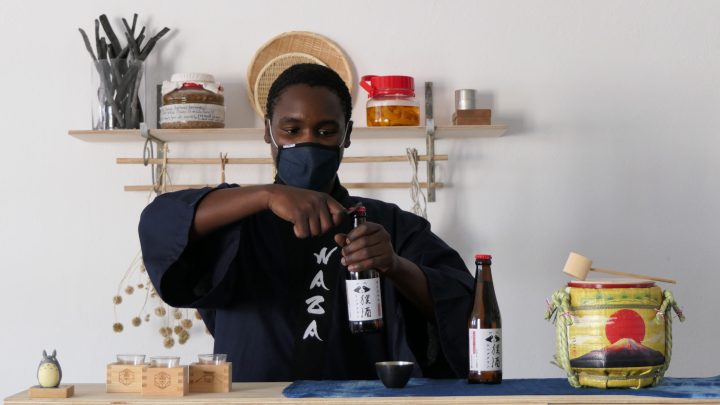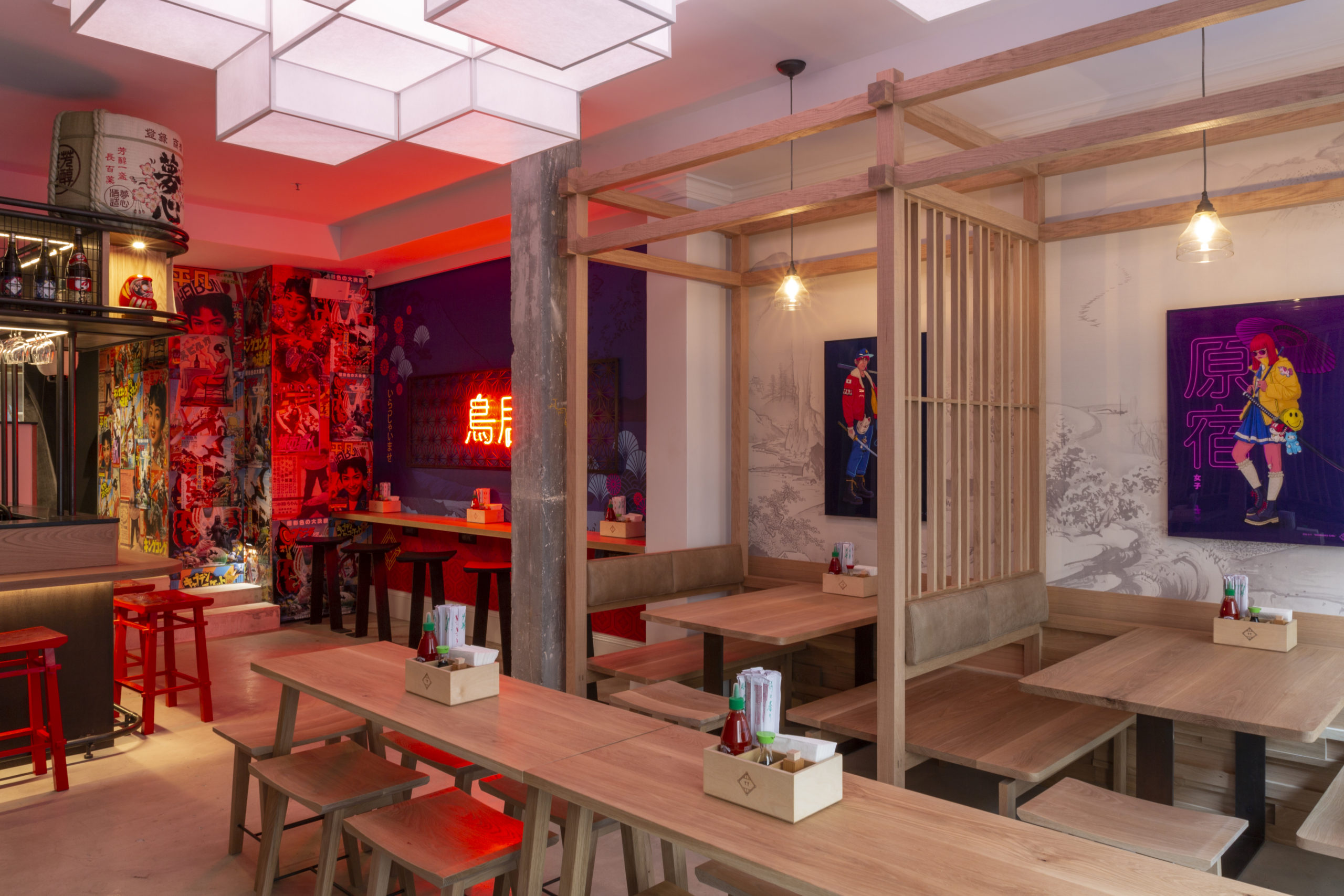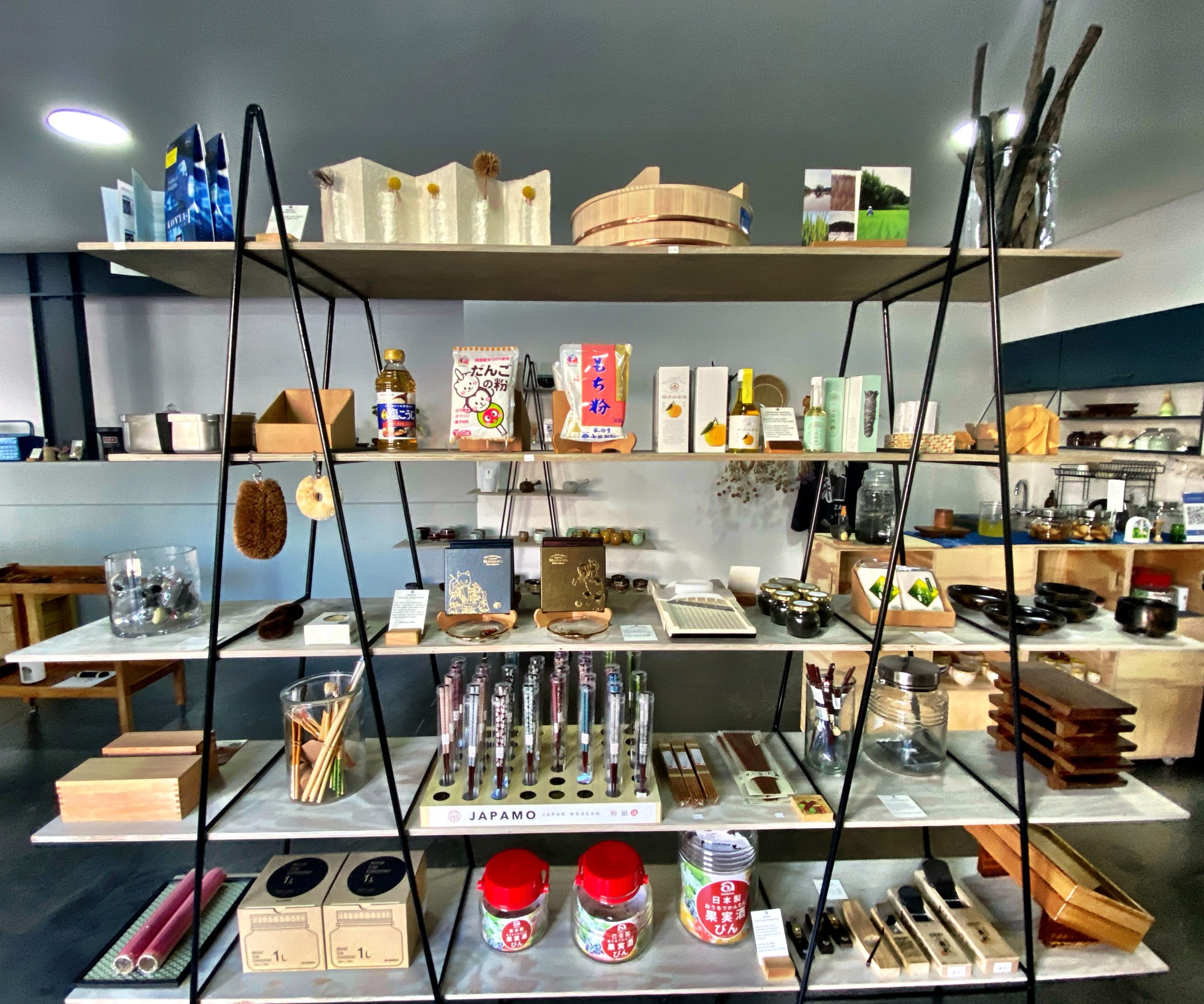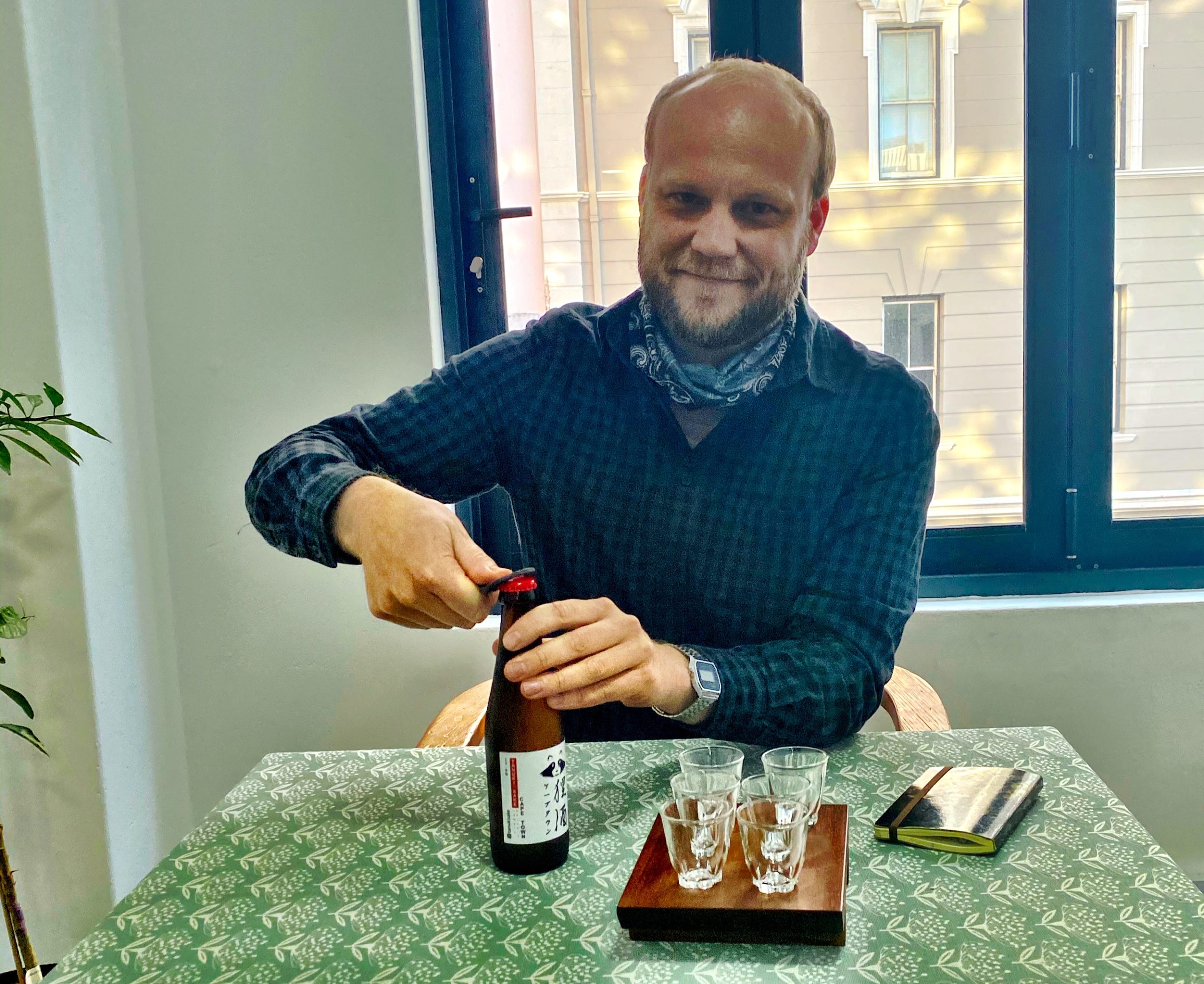和 ZA
Sip local sake with Cape Malay cookies

Japan holds an eternal allure for visitors from the West. At WAZA Japan Labo, you can immerse yourself in the products – imported as well as created in South Africa with Japanese inspiration – plan your first (next) trip, or take off your shoes and sit on the tatami with a bowl of vibrant green matcha and Cape Malay cookies.
Without getting too deep into the intricacies of Japanese grammar, the particle “wa”, which means variations of peace, harmony and calmness, can be affixed to anything that is intrinsically Japanese, the core traditional values of the culture. Washi is paper, wagyu is the famous Japanese cattle which produce beautifully marbled beef, and washoku is traditional cuisine.
The kanji for wa is 和, and it’s incorporated into the WAZA Japan Labo logo as a little house with a window, explains Botha Kruger. The ZA is for South Africa, and Labo is a typically Japanese manner of shortening words; in this case, laboratory.
“Waza also means technique or skill in Japanese so we have this theme of where Japan meets South Africa,” said Botha.
Following some dreadful timing which saw WAZA open briefly at the beginning of March then close for 10 weeks, it reopened in June. The second-floor space in Loop Street is a long room filled with furnishings that can be moved and rearranged to suit different needs, be it a workshop, a demonstration, a soy sauce tasting, or an event – public or private. At the far end, there is a tatami mat set with a low table where visitors can remove their shoes, and sit on the woven mat floor and partake of whisked matcha or refreshing green tea accompanied by Cape Malay-style cookies made by Gadija Khan of KaapseKos.
This perfectly illustrates the meeting of East and West, Japan and South Africa. Additionally, the imported products on the movable shelves – like calligraphy supplies, mochi flour and wasabi oil – are complemented by locally made items that have been inspired by Japanese design. Wooden chopstick rests and wooden plates by artist Wim Botha, for example.
Kruger and his wife Hilda have visited Japan eight times since 2004, their love for the country increasing each time. “Everyone loved the quality of the stuff we brought back as gifts and kept asking where they could get it in South Africa,” said Botha. The obvious reaction was to create a place where this could happen.
With his background as a business consultant, Kruger thought, how difficult can it be? He began making contact with Japanese companies, some of which were quite surprised to hear from him, all the way over here in SA. It began with garden tools and an online shop. Slowly, the range of products swelled, weekend pop-ups took place, and a retail space was opened in Salt River. “This year we wanted to create an events space, a workshop space, an experience space,” said Kruger.
Future plans include a proper little old-school library from which you can borrow books about Japan, and a clothing range. Kruger is on hand to offer travel advice.
Everyone will have a different reason for their attraction to Japan; what Kruger likes about it is the considerateness of the people and how they co-exist. “Wa means harmony and peace, and in an island country of 127 million people living very close to each other, understanding of this taking of others into consideration is something I admire. The appreciation of quality and the little things is another reason; you can go into a shop and buy the smallest, most inexpensive thing and you’ll be treated the same as someone who spent a great deal of money,” he said.
Every little thing matters, so the term “mottainai” is another thing Kruger cited to explain his partiality. Simply translated, it means “What a waste!” and is an expression of dismay when this is witnessed. It’s used to encourage people to reduce, reuse and recycle – which could be adopted globally.
“If you discard something and I see you, I can say to you ‘mottainai’ and it’s understood,” explained Kruger.
WAZA Japan Labo is not a restaurant but you can get your teas and soft drinks, and the cookies. You’re also welcome to bring your Japanese-style takeaway and enjoy it in this environment. I think there’s a line drawn when it comes to KFC or a Big Mac, and rightly so. Tjing Tjing, around the corner in Longmarket Street, has three levels, with three different offerings.
“Torii, on the ground floor, is our casual street food style eatery, serving bites and bowls in a funky Harajuku inspired space. Momiji, on the middle floor, includes Momiji Lounge, a sophisticated lounge and bar, suitable for private events or cocktails, as well as Otsumami (bar snacks),” said chef Christi Semczyszyn.

Tjing Tjing Rooftop is a cocktail bar, with an outside rooftop area, ideal for after work or pre dinner drinks and snacks. (Photo: Supplied)
“Momij serves our seasonal Kaiseki style fine dining menu, Thursday to Saturday evenings, in a serene and tranquil room. Tjing Tjing Rooftop is our cocktail bar, with an outside rooftop area, ideal for after work or pre-dinner drinks and snacks.”
Before lockdown, Tjing Tjing was working with WAZA by preparing small snacks to serve with tea at their store throughout the day on Tjing Tjing Tuesdays. “We will continue to collaborate with them on future projects,” said Semczyszyn.
“They have imported some beautiful items and ingredients from Japan for us, and we have previously provided snacks for a launch for them.”
From November 2, Mochi Mochi will open next door to Tjing Tjing, as a pop-up in collaboration with Molten Toffee. “Mochi Mochi will focus on Japanese confections and baked goods, which our pastry chef, Adri Morel, hand crafts,” said Semczyszyn. “Some items on offer will be various exciting flavours of mochi, Japanese cheesecake, milk bread sandos and mitarashi dango.”
Wait, what? What is mochi? A Japanese rice cake, and the flour that goes into them is available at WAZA. Since the average person would have no clue about that, Kruger is planning a monthly stall at Oranjezicht City Farm Market at the V&A Waterfront, which he will call Min Konbini (convenience store, that shortening of words again). His reasoning is there is not much point in selling something no one knows how to use, so this stall will have food made with the “strange” ingredients, or chefs demonstrating how to make them.

WAZA Japan Labo sells locally made Japanese-inspired items, as well as imported goods. (Photo: Bianca Coleman)
We all know sushi of course, but since those ingredients are readily available in supermarkets, WAZA focuses more on speciality items, like aged soy sauce. If it had a licence to sell sake, it would. If the guys from Tanuki sake could sell their product, they would too, but there is a tangle of red tape in the way at the moment.
Tanuki sake is made right here in Cape Town by Ulrich Terblanche and Brock Kuhlman, who met about two years ago when they were carpooling in Stellenbosch where Kuhlman was – is – doing his PhD in winemaking.

Ulrich Terblanche ready to pour a taste of the sake he and partner Brock Kuhlman created from a long process of experiments. (Photo: Bianca Coleman)
“After a year or so we started having discussions and I found out he lived in Japan for about five years – and is fluent in the language,” said Terblanche. “One of the things I haven’t been exposed to a lot in South Africa, is sake. Some I have tasted here weren’t the best. So we were talking about sake and I commented on how hard it is to find, and even if you do, it’s the same brand everywhere.
“’Well, if you really want sake, we can make it. It’s not that hard,” Brock said. In Japan people do it in their houses, like we brew beer in their garages here.”
So they decided to give it a go, with a five litre bottle. Sake has only four ingredients: water, rice, yeast and koji. However, they have to be of the highest quality. Koji is a fungus used in a variety of fermented products, like kimchi and soy sauce.
“Basically what it does is it produces enzymes which break down the starch of rice and converts it to sugar, and for fermentation you need sugar, which in turn becomes alcohol when the yeast is added,” said Terblanche.
“With this parallel process you can achieve much higher alcohol levels than with beer, for instance. Some sakes can reach up to 18 to 20% alcohol max, but normally it’s similar to wine.”
Terblanche and Kuhlman experimented extensively. They tried different waters, from filtered tap to Newlands spring. That was the easy part. Rice, not so much.
“Just like the wine industry in South Africa, you get different varieties of rice and each region of Japan grows its own type of rice,” said Terblanche. There are roughly 62 sake rice varieties, all with different qualities and tastes. That’s just sake rice, mind, not the eating rice, which apparently is far superior to anything we get here. “You don’t want the proteins of table rice, that’s a whole different ball game. And they do not export their rice,” continued Terblanche.
“There are japonica type species of rice from Japan that are grown in other countries. In Cape Town, we source japonica rice from Vietnam or Australia.”
Yeast is also difficult because there are specific sake yeast strains. “We didn’t have it when we started so we experimented with white wine yeast – Chardonnay yeast basically. It had such a major taste impact, at the end of the day the sake tasted like Chardonnay,” laughed Terblanche. “That was challenging. The koji was easier to source – WAZA stocks koji spores. You add that to the rice and grow them in a contained hot humid environment, which is difficult to get right.

KC Ndukwana opens a bottle of locally made Tanuki sake. (Photo: Supplied)
“But if you do, then you look at combining the other ingredients. You can put everything together and hope for the best but you could have problems with unwanted bacteria. At the beginning we tried some simple recipes online, and later we found some guides from Japan, created for sake brewers there, that is more temperature controlled.”
The experimenting expanded, wives became tetchy about all the buckets of sake – the process is a month or longer, deep freezers and fish tanks were “MacGyvered”… but there came a time when the successes outweighed the failures.
The turning point came with access to a winemaking lab which had the equipment they needed. “It was for a short time but we took that opportunity to see if our recipe worked on a large scale – we went from a bucket to a 200 litre tank,” said Terblanche. “The nice part is we had access to proper filtration, and pasteurisation.”
As a comparison, Terblanche opened a box sake for us to taste first. It’s imported to South Africa in bulk and readily available. “Ours is not the same but it’s a good guide,” said Terblanche.
Many South Africans are not familiar with sake; there’s a misconception that it’s a shot, a strong liquor, which it is not. The taste testers liked the “Chardonnay” sake because it was something they recognised, commented Terblanche.
The box sake was on the sweeter, more floral side while Tanuki sake is dryer. For me, it had an almost-beer flavour, which Terblanche said could be the yeast. It gave me the impression it could happily become a sparkling sake (which is a Real Thing).
The next question was how and when to drink sake. Warm or cold? “You can drink it either way, it depends on your personal preference,” said Terblanche. “But you wouldn’t want to take a high quality sake and make it warm. However, warm sake isn’t necessarily a poor sake.”
Terblanche suggested you can drink it with white meat, and definitely not with strong overwhelming dishes like curries. “You won’t get the finer taste. Fish is brilliant, it doesn’t have to be sushi – any kind of fish. I enjoy it with snacks and a picnic.”
The name Tanuki is that of a real creature which we would call a raccoon dog in English. It’s not either of those things, but resembles both animals. It’s also a mythical figure in Japanese folklore where it’s known as a trickster and shape shifter that enjoys drinking sake and is often depicted drunk. “They also have giant balls,” said Terblanche. Yes, those balls.
Choosing the name was appropriate because he and Kuhlman are tricksters – making a Japanese product in South Africa – and they also have the balls to actually do that in the first place.
“Plus the word is easy off the tongue,” he added.
All the boxes then.
There’s presently one big complication though: to manufacture and sell alcohol you need a liquor licence. The problem is, there is no classification for fermented rice wine anywhere in the liquor bill. If it’s a beer it has to have barley and hops; if it’s a wine it has to be made from grapes; a cider has to be fruit; and a spirit must be distilled. Sake is clearly none of those things.
Terblanche and Kuhlman are more than welcome to make it – for their own consumption or to give away as gifts – but they cannot sell their sake. Apparently, a revision of the regulations to allow “fermented beverages” has been sitting on Cyril’s desk for about two years waiting to be signed off.
Until that happens, the only way to sample this lovely sake is by arranging a tasting, or an event, or through a similar loophole. For more information, follow Tanuki on Instagram or email [email protected] [email protected]
I don’t know about you but I’m feeling rather hungry now. Besides Tjing Tjing, here are some Japanese-style restaurants you might want to try.

The fare at Shio. (Photo: Supplied)
Shio Modern Japanese Izakaya in De Waterkant is a tasting experience with a menu designed to allow guests to choose their own food journey. Next door is the former Piano Bar which has been reinvented by Cheyne Morrisby as ラッキー Lucky. “It’s a more fun yet stylish approach to Japanese cuisine. The menu was designed from what Kissatens (jazz clubs) would offer in the 1930s in Japan – real simple food, sandwiches, noodles and grills,” he said.
Morrisby said he is attracted to Japanese cuisine by the simple use of ingredients. “Without overworking them, you can use traditional cooking methods and bring them into a modern feel quite easily. The Japanese food culture is very much about love and respect for the product and how it’s cooked, presented and eaten.”
Although he’s not been to Japan, Morrisby’s love for the food began in London when Japanese cuisine entered the food scene in the early ’90s. “I ended up working with some incredible Japanese chefs who taught me the intro and basics to Japanese cuisine. I then used this knowledge when working at other Pan Asian restaurants to create my own style. The ‘aha!’ moment was eating at Nobu in the early ’90s and eating Black Cod for the first time, and I thought ‘damn I need to find out how to do this’!”
Japanese cuisine is very much about flavour layering and not blending, something Morrisby uses in all his dishes. Right now, he’s crazy about the Japanese Black Rice risotto (forbidden risotto) from Shio, which represents him and his style.

Kyoto grilled seafood at Kyoto Garden Sushi. (Photo: Supplied)
Scott Wood opened Kyoto Garden Sushi in Tamboerskloof 14 years ago, which serves more than just sushi. “I first ate sushi in 1974 in Little Tokyo in downtown Los Angeles on a date. My date had insisted on trying sushi. This started my obsession,” said Wood.
The foundation of Wood’s love of Japan was in 1985 he first visited the Tsukiji fish market in Tokyo after a night out. “It was on the way home. I got to the market at 4am. It was an incredible experience and changed me. I try to visit Japan once a year, it’s like a pilgrimage. It inspires me.”
Wood said he is still learning about Japanese cuisine, even after all these years. “There is a subtlety and purity to the flavours. The use of umami. The precision in sushi. There is an underlying belief in the cuisine that less is more.
“The quality of ingredients is key, then to enhance them and let them shine. I spend a lot of effort on tracking down quality fish.”
Wood’s recommended dishes at the moment are the vegetable tempura, sea soup, grilled wagyu and steamed fish in a bamboo pot.
“To make the tempura light and crispy and fresh tasting, this is the aim. We use Japanese flour, and the oil is changed every day. When it’s really done right, each piece of tempura is a bite of wonder.”
At Kyoto – something which has always stood out for me – you get fresh wasabi. “It’s grated at the table,” said Wood. “We are lucky to have fresh supplies. It is an experience, not too hot but a clean, pure taste in perfect balance.” DM/TGIFood
For an immersive Japanese experience, Kruger did an episode for the Wrong Rock Show for Bush Radio during lockdown. You can stream here. More information about WAZA Japan Labo is here.





 Become an Insider
Become an Insider
Comments - Please login in order to comment.